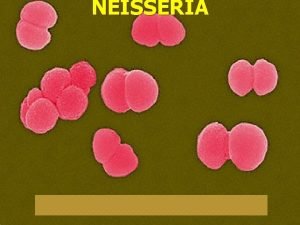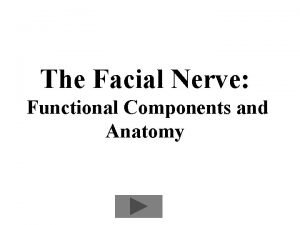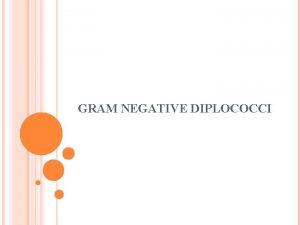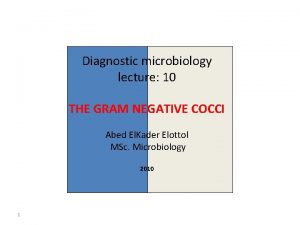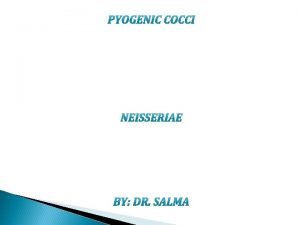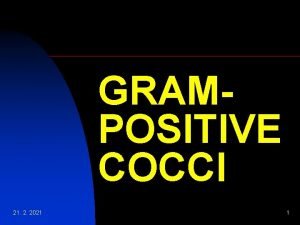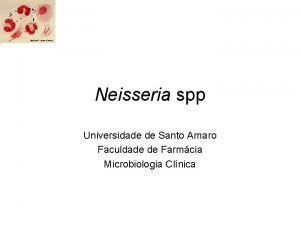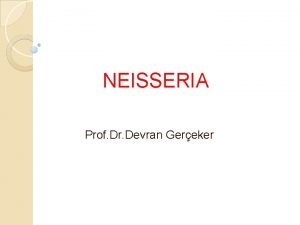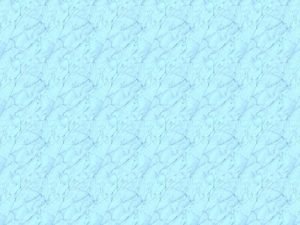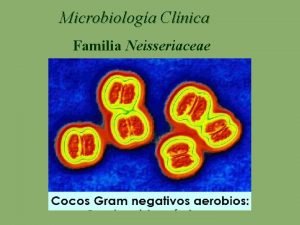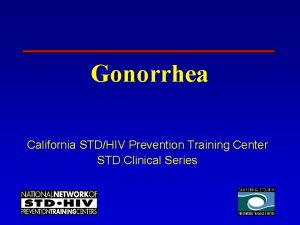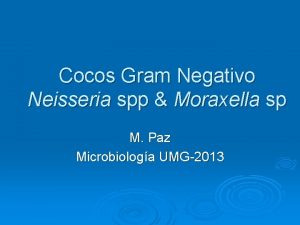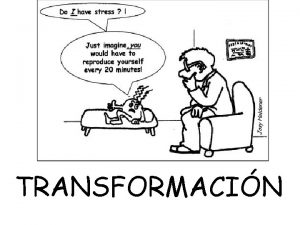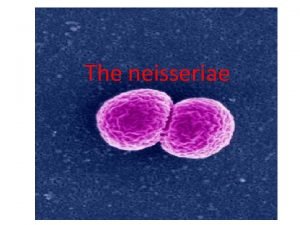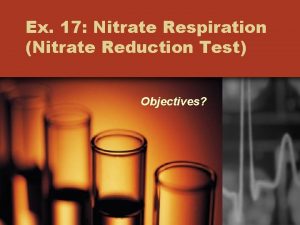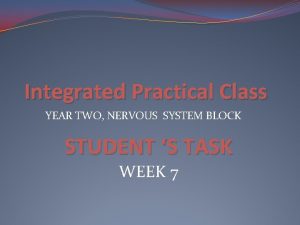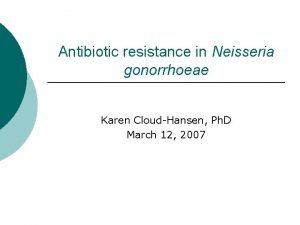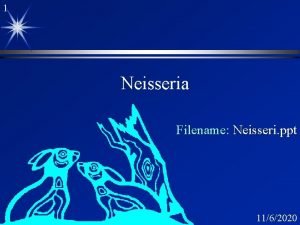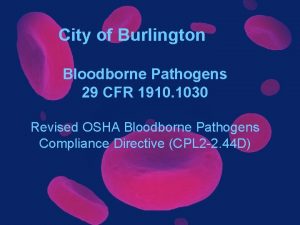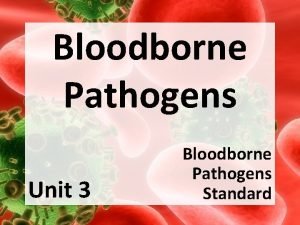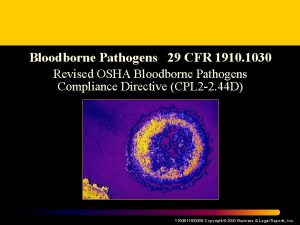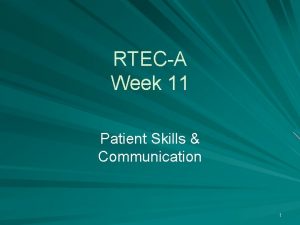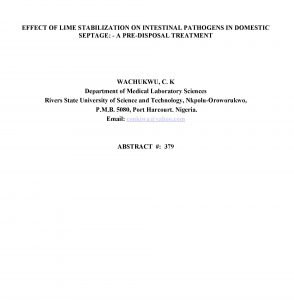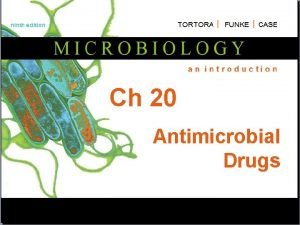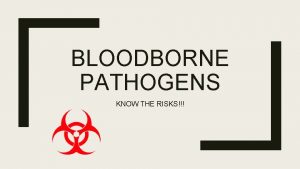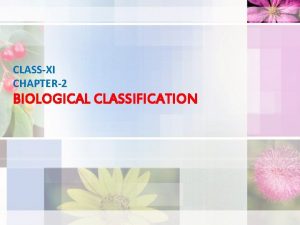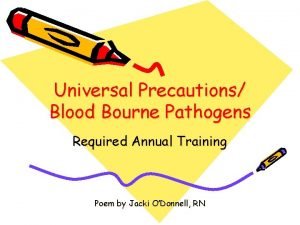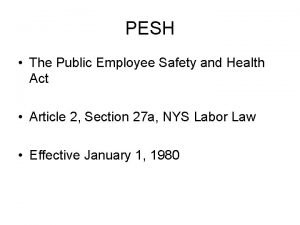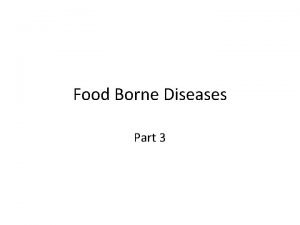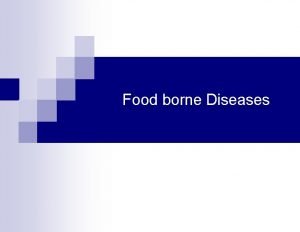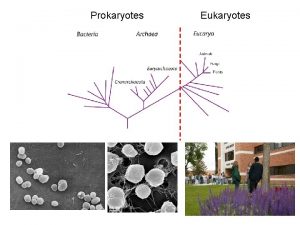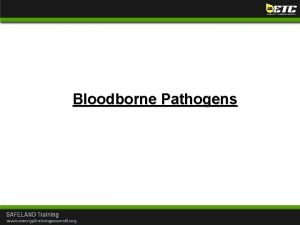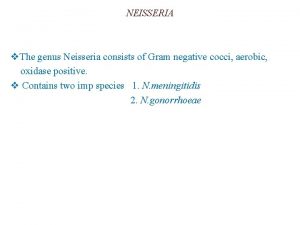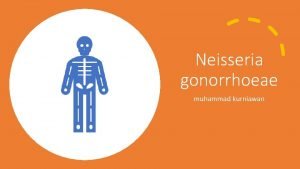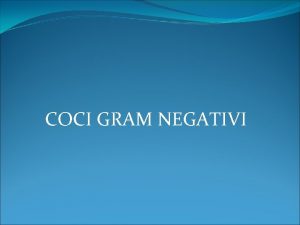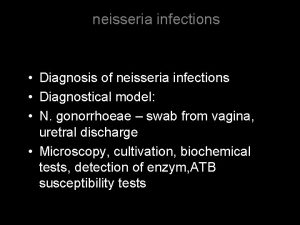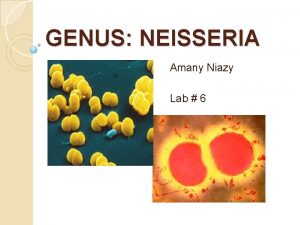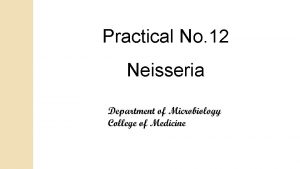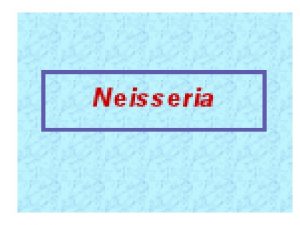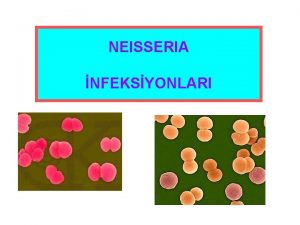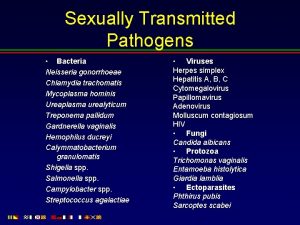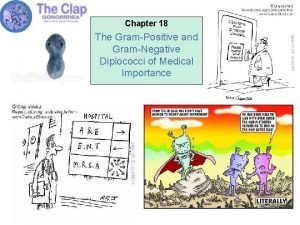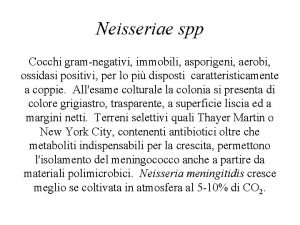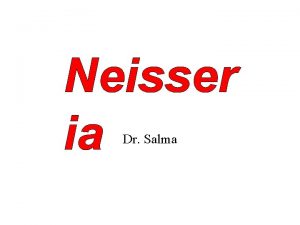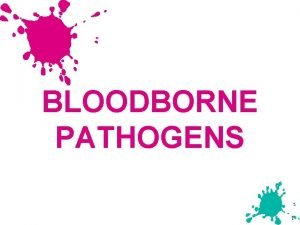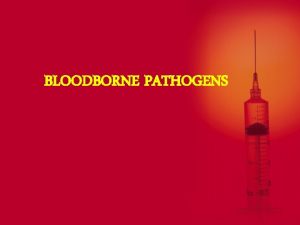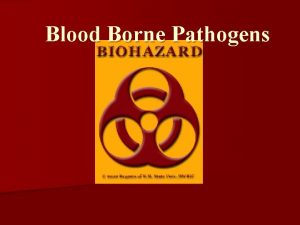NEISSERIA Introduction The Neisseriae are Gve diplococci Pathogens


































- Slides: 34

NEISSERIA

Introduction Ø The Neisseriae are G-ve diplococci Ø Pathogens are: - N. meningitidis Ø N. gonorrhoeae Ø Exacting growth requirements Ø Commensals easy to grow on ordinary media

N. gonorrhoeae Obligate parasite of human urogenital tract. Ø Morphology: Gram -ve diplococci (bean shaped). Ø Culture: enriched media (lysed blood or chocolate), moist aerobic atmosphere +5 -10% CO 2. Temp. 3537 o. C. Ø

Gram stain of N. gonorrhoea

Selective media Ø Thayer-Martin medium contains vancomycin, colistin, nystatin & trimethoprim. Ø Colonies: 48 hrs incubation.

Identification Ø Oxidase +ve. Ø Carbohydrate utilization: N. gonorrhoeae produces acid from glucose only. Ø Slide agglutination with specific antisera (Phadebact test).

Pathogenicity Causes gonorrhoea Ø Arthritis, Ø Septicemia, Ø Ø Ophthalmia neonatorum.

Gonorrhoea Acute pyogenic infection of urethra and (in females) cervix. Ø Acute purulent urethral , vaginal discharge , dysuria Ø Asymptomatic in females Ø Rectum & oropharynx may be involved. Ø

Complications Ø Prostatitis, epididymitis , urethral stricture in males. Ø Salpingitis , infertility in females Ø Septicemia Ø Arthritis Ø Meningitis (rare).

Diagnosis Ø Ø Ø Specimen: urethral, cervical smears &swabs (transport medium). Gram film: intracellular Gram -ve diplococci Culture: selective media Oxidase +ve acid production from glucose Latex agglutination

Treatment of gonorrhoea Ø Ø Ø One curative dose Sens. Testing Blind treatment: ceftriaxone, ciprofloxacin Spectinomycin Penicillin: resistance common.

N. meningitidis Habitat: human nasopharynx (10 -25%) Ø Similar to N. gonorrhoea but less exacting ? Ø Can grow in BA, Chocolate agar without selective media from CSF ? Ø Id. CHO utilization: acid from glucose & maltose. Ø

Gram stain of Neisseria meningitis

Haemorrhagic rash

Death from Waterhouse-Friderichsen syndrome

Neck rigidity

Antigenic structure Ø Polysaccharide antigens Ø Three main groups A, B, C Ø Other groups Y, W 135. Ø Grouping: slide agglutination with specific antisera

Pathogenicity Meningococcal meningitis, as a spread from nasopharynx blood stream meninges in susceptible hosts. Ø Direct spread to meninges Ø Rash Ø Adrenal haemorrhage (Waterhouse-Friderchsen syndrome) Ø

Meningitis Ø Ø Ø Clinically: rapid deterioration of flu like illness Headache, neck stiffness, +ve kerning’s sign, fever, . . … Diagnosis: CSF + blood culture CSF: WBC , RBCs Gram stain: bacteria & cells

Meningitis (Continue) Culture deposit into blood & chocolate agars and glucose broth 7 cooked meat media Ø Incubate in air + 5%CO 2 Ø Id : sugar utilization + latex Ø For partially treated meningitis: detection of bacterial antigen by: latex agglu, CCIE. . for common serogroups of meningitis pathogens. Ø

Treatment Parenteral antimicrobial Ø Start blind treatment after collection of specimens by: Ø § § Ceftriaxone or cefotaxime Change later according to sens. Test. Contacts: rifampicin Prevention: vaccination (polyvalent)

Commensal Neisseriae N. pharyngis, N. flava, N. sicca, . . Ø In mucous mem. Of mouth, nose, pharynx, less common in genital tract. Ø Differ. From pathogenic one: Ø grow in ordinary media( no CO 2) § at room temp. § rough, pigmented § acid from a number of CHOs §


Other causes of meningitis Ø Ø Ø Bacterial causes: Three primary pathogens: N. meningitidis, HI, S. pneumoniae N. menningitidis all ages HI 2 m-5 y S. pneumoniae all ages but more common in adult with underlying illnesses.

Other causative bacteria (Continue) Ø E. coli & other coliforms Ø Listeria Ø Strept. group B Ø Salmonella spp. Ø Favobacteria. . Ø All common in neonates

Other causative bacteria (Continue Ø After surgery or trauma Ø S. aureus Ø S. pneumoniae Ø AFB chronic meningitis Ø Spirochaetes

Other Causes Ø Viral : enterivirus, Paramyxovirus, Herpes viruses, adenoviruses, arboviruses. Ø Fungi: yeasts (Candida, cryptococcus spp. ) Ø Aspergillus spp. Ø Mucor

Findings in CSF Normal CSF: Ø Clear , colorless Ø 0 -5 lymphocytes Ø Sterile Ø 150 -450 mg /l protein Ø 2. 8 -3. 9 mmol/l glucose

CSF in bacterial meningitis Ø Ø Ø Turbid 500 -20, 000 cells mainly polys, few lymphocytes Bacteria in Gram stain Markedly raised protein Reduced or absent glucose

CSF in TB meningitis Ø Ø Ø Clear or slightly turbid 10 -500 cells, mainly lymphocytes( polys early) AFB in Z-N stain Grow in LJ medium Moderately raised protein Sugar reduced

CSF in viral meningitis Ø Clear or slightly turbid Ø 10 -500 cells mainly lymphocytes Ø Stool culture, or serology +ve Ø Normal or slightly raised protein Ø Normal glucose

Cerebral abscess Ø Clear or slightly turbid Ø Bacteria: S. milleri, Bacteroides, S. aureus. Proteus(Causative bacteria) Ø 0 -500 mainly polymorphs Ø Often no organisms in CSF Ø Normal or raised protein Ø Normal glucose

Complication of meningitis Ø Ø Ø Death ( 30% with pneumococci, 10% Hi & N. meningitidis. Ventriculitis hydrocephalus Paralysis Cerebral abscess. .

Treatment of meningitis Ø Depends on age , causal bacteria Ø Urgent , parenteral Ø Ceftriaxone Ø Neonates: amp+ gm (or ceftriaxone) Ø Sens. testing Ø Anti TB
 Neisseria diplococci
Neisseria diplococci Antigentest åre
Antigentest åre Sve nerve
Sve nerve Gram negative diplococci
Gram negative diplococci Gram negative diplococci
Gram negative diplococci Cocciare
Cocciare G+ diplococci
G+ diplococci Neisseria meningitidis prophylaxis
Neisseria meningitidis prophylaxis Meio de cultura para neisseria gonorrhoeae
Meio de cultura para neisseria gonorrhoeae Neisseria gonorrhoeae özellikleri
Neisseria gonorrhoeae özellikleri Neisseria gonorrhoeae aerobic
Neisseria gonorrhoeae aerobic Factores de virulencia de neisseria gonorrhoeae
Factores de virulencia de neisseria gonorrhoeae Youtube.com
Youtube.com Neisseria gonorrhoeae
Neisseria gonorrhoeae Caracteristicas de neisseria meningitidis
Caracteristicas de neisseria meningitidis Neisseria
Neisseria Neisseria gonorrhoeae kingdom
Neisseria gonorrhoeae kingdom Neisseria gonorrhoeae nitrate test
Neisseria gonorrhoeae nitrate test Neisseria meningitidis tratamiento
Neisseria meningitidis tratamiento Neisseria meningitidis
Neisseria meningitidis Gonorrhea
Gonorrhea Neisseri
Neisseri Bloodborne pathogens quiz answers
Bloodborne pathogens quiz answers Unit 3 bloodborne pathogens standard
Unit 3 bloodborne pathogens standard Bloodborne pathogens quiz answers
Bloodborne pathogens quiz answers Blood borne pathogens
Blood borne pathogens Major human pathogens
Major human pathogens Inhibition of nucleic acid synthesis
Inhibition of nucleic acid synthesis Bloodborne flora
Bloodborne flora Bloodborne pathogens know the risk
Bloodborne pathogens know the risk Six kingdoms worksheet
Six kingdoms worksheet Blood bourne pathogens
Blood bourne pathogens Public employee safety and health
Public employee safety and health Food borne pathogens
Food borne pathogens Food borne pathogens
Food borne pathogens
